In 1709, the Italian craftsman Bartolomeo Cristofori from Florence created an instrument that used hammers to produce both loud (forte) and soft (piano) sounds. This is why the instrument was called the “fortepiano”. Among its many predecessors are the harpsichord and clavichord.
In the early 19th century, the cast-iron frame and cross-stringing were invented, resulting in a better quality and appearance of the grand piano. The grand piano is a musical instrument in which the strings, the soundboard and the mechanical part are arranged horizontally, the body is wing-shaped and the sounds are produced by the striking of felt hammers against the strings with the keys. Unlike the upright piano, the sound of the grand piano is more expressive and rich in timbre, the keyboard is more sensitive, the performance is more virtuosic, and the range of gradations of sound variation is wider.
From the 1850s the factory production of grand pianos began in Europe (especially rapidly in Germany), America and Russia. The grand piano became the “king” of musical instruments. By the early 20th century, the grand piano took on its modern form: wooden body, one-piece armored cast-iron frame, double escapment action. Nowadays, there are two main varieties of pianos: grand pianos, designed for concert performance (there are also relatively small, “cabinet” pianos), and upright pianos, used for home music-making.
The factory of Christoph Gentsch was founded in 1865 in Saint Petersburg. The factory was considered one of the oldest in Russia and specialized in making small pianos for the people with modest income. The tone of the instruments was muffled in the upper and middle registers and ringing in the basses. This peculiarity allows specialists to identify the instrument even today. There have been cases of soundboards breaking, as the latter were made too weak and thin. The use of a second soundboard patented by Gentsch in 1882, connected to a normal soundboard by a series of interconnecting rods (soundposts), did not help to improve the sound quality.
The Gentsch factory’s production was located in the companies of the Izmailovsky Regiment and the instruments were sold in Gentsch’s own shop at 51 Liteyny Prospect. At the end of the 19th century the factory was closed down.
In the early 19th century, the cast-iron frame and cross-stringing were invented, resulting in a better quality and appearance of the grand piano. The grand piano is a musical instrument in which the strings, the soundboard and the mechanical part are arranged horizontally, the body is wing-shaped and the sounds are produced by the striking of felt hammers against the strings with the keys. Unlike the upright piano, the sound of the grand piano is more expressive and rich in timbre, the keyboard is more sensitive, the performance is more virtuosic, and the range of gradations of sound variation is wider.
From the 1850s the factory production of grand pianos began in Europe (especially rapidly in Germany), America and Russia. The grand piano became the “king” of musical instruments. By the early 20th century, the grand piano took on its modern form: wooden body, one-piece armored cast-iron frame, double escapment action. Nowadays, there are two main varieties of pianos: grand pianos, designed for concert performance (there are also relatively small, “cabinet” pianos), and upright pianos, used for home music-making.
The factory of Christoph Gentsch was founded in 1865 in Saint Petersburg. The factory was considered one of the oldest in Russia and specialized in making small pianos for the people with modest income. The tone of the instruments was muffled in the upper and middle registers and ringing in the basses. This peculiarity allows specialists to identify the instrument even today. There have been cases of soundboards breaking, as the latter were made too weak and thin. The use of a second soundboard patented by Gentsch in 1882, connected to a normal soundboard by a series of interconnecting rods (soundposts), did not help to improve the sound quality.
The Gentsch factory’s production was located in the companies of the Izmailovsky Regiment and the instruments were sold in Gentsch’s own shop at 51 Liteyny Prospect. At the end of the 19th century the factory was closed down.



